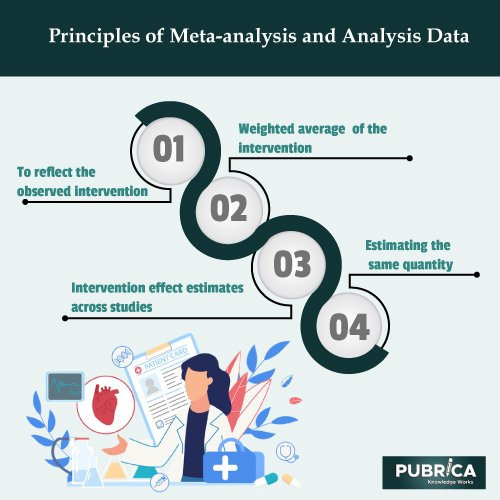
How do you write an evidence-based clinical literature review?
November 9, 2021
Online Proofing System for faster Publication of researches
November 24, 2021In brief
The statistical combining of data from two or more distinct research is known as meta-analysis. Meta analysis research may provide benefits such as increased precision, the capacity to answer problems not addressed by individual research, and the ability to resolve disagreements resulting from competing claims. However, if specific research designs, within-study biases, variance among studies, and reporting biases are not adequately evaluated, they can mislead substantially. It’s critical to appreciate the data types that emerge from measuring an outcome in a single research and select appropriate effect measures for comparing intervention groups.
Introduction
The critical examination of whether it is suitable to integrate all numerical data, or possibly some, the research is a crucial stage in a systematic review. An overall statistical data analysis that describes the efficacy of an experimental intervention compared to a comparator intervention is produced by such a meta-analysis. Some of the potential advantages of meta-Analysis include:
- To improve precision. Many studies are too small to give conclusive data on the impact of interventions on their own. Estimation is frequently enhanced when additional data is available.
- To provide answers to questions that were not addressed in the individual research. A specified type of participant and well-defined interventions are common in primary research. A group of studies with different features can examine the consistency of impact over a wider variety of people and treatments. It may also enable the investigation of causes for variations in impact estimates, if applicable.
- To resolve conflicts resulting from apparently contradictory studies, the degree of disagreement may be officially examined. The causes for various outcomes can be studied and quantified using a statistical synthesis of findings.

Principles of meta-analysis
The following are the main concepts that most meta-analysis methodologies follow:
- Meta-analysis is usually done in two stages. A summary statistic is computed for each research in the first step to reflect the observed intervention effect across all studies consistently. If the data are binary, the summary statistic may be a risk ratio; if the data are continuous, it might be a difference between means.
- In the second step, a weighted average of the intervention effects assessed in the various studies is used to calculate a summary (combined) intervention effect estimate.
- The assumption that the studies are not all assessing the same intervention effect but rather estimate intervention effects that follow a supply across studies might be included in the combination of intervention effect estimates across studies. A random-effects meta-analysis is based on this foundation. On the other hand, a fixed-effect systematic review meta analysis is undertaken if it is considered that each research is estimating the same quantity.
For both individual studies and meta-Analysis, a forest plot presents effect estimates and confidence ranges. A block depicts each research with a horizontal line extending on each side to estimate intervention impact. The block area represents performing a meta analysis burden assigned to that research, while the horizontal line represents the confidence interval.
- Pubrica medical writers help you to write and edit the introduction, by introducing the reader of the shortcomings or emptyspaces in the identified meta anlysis research field. Pubrica’s team of researchers and authors develop Scientific and medical research papers that can act as an indispensable tool to the practitioner/authors.
A generic inverse-variance approach to meta-analysis
The inverse-variance approach is a persistent and straightforward variation of the meta-analysis procedure. This method is utilised behind the scenes in many meta-Analysis of dichotomous and continuous data, and it is implemented in RevMan in its most basic version.
The inverse-variance technique gets its name because each study’s weight is set to equal the inverse of the impact estimate’s variance. This balancing strategy reduces the pooled impact estimate’s imprecision (uncertainty). As a result, more extensive research with more minor standard errors receive more credit than smaller studies with more significant common mistakes.
Meta-analysis of rare events
Meta-analysis may be the only option to provide credible evidence of the effects of healthcare treatments for unusual outcomes. Individual studies are typically underpowered to detect differences in uncommon outcomes. Still, a meta-analysis of several studies may have sufficient power to evaluate whether treatments affect the occurrence of the rare event. However, many meta-analysis approaches rely on large sample approximations, which are ineffective when rare circumstances occur.
Interpretation of subgroup Analysis and meta-regressions
Subgroup comparisons are observational Subgroup Analysis, and meta-regressions are observational studies that look for differences between researches. They have the same limitations as any observational research, including the possibility of bias due to other study-level variables. Even if there is an actual difference between subgroups, the categorisation of the subgroups is not always the cause of the difference. A subgroup study of bone marrow transplantation for the treatment of leukaemia, for example, may reveal an important link between the recipient’s age and that of their sibling.
While specific statistical Research analysis service Analysis can be described in the study protocol, many acceptable issues for sensitivity analysis are only discovered during the review process. When sensitivity Analysis reveal specific judgments or missing data that significantly impact the review’s results, more resources might be allocated to resolving uncertainties. If this isn’t feasible, the results should be approached with care. Such findings may lead to requests for more studies and investigations.
Conclusion
To summarise the findings of this meta analysis writing service, this would say that the studies included in the comments were heterogeneous, that their effects were minor, and that most studies pointed to a small amount of reduction that might not be clinically very relevant, and that this meta analysis has missed small studies with effect estimates in opposite directions, leaving room for publication bias and need to do further research on the association based on this meta analysis.
About Pubrica
Pubrica’s team of researchers and authors develop Scientific and medical research papers that can act as an indispensable tool to the practitioner/authors. Our experts are aware of the structure that follows the broad topic, the problem, and background and advance to a narrow topic to state the hypothesis.
References
- Anzures-Cabrera J, Sarpatwari A, Higgins JPT. Expressing findings from meta-Analysis of continuous outcomes in terms of risks. Statistics in Medicine 2011; 30: 2967-2985.
- Berlin JA, Santanna J, Schmid CH, Szczech LA, Feldman KA, Group A-LAITS. Individual patient- versus group-level data meta-regressions for investigating treatment effect modifiers: ecological bias rears its ugly head. Statistics in Medicine 2002; 21: 371-387.
- Borenstein M, Hedges LV, Higgins JPT, Rothstein HR. A basic introduction to fixed-effect and random-effects models for meta-analysis. Research Synthesis Methods 2010; 1: 97-111.
- Mathur, Maya B., and Tyler J. VanderWeele. “Methods to address confounding and other biases in meta-Analysis: Review and recommendations.” Annual Review of Public Health 43 (2021).
